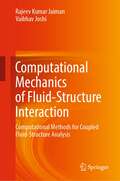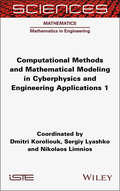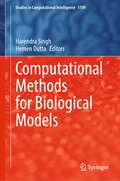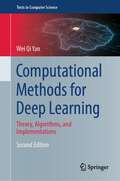- Table View
- List View
Computational Mathematics Modeling in Cancer Analysis: First International Workshop, CMMCA 2022, Held in Conjunction with MICCAI 2022, Singapore, September 18, 2022, Proceedings (Lecture Notes in Computer Science #13574)
by Wenjian Qin Nazar Zaki Fa Zhang Jia Wu Fan YangThis book constitutes the proceedings of the First Workshop on Computational Mathematics Modeling in Cancer Analysis (CMMCA2022), held in conjunction with MICCAI 2022, in Singapore in September 2022. Due to the COVID-19 pandemic restrictions, the CMMCA2022 was held virtually. DALI 2022 accepted 15 papers from the 16 submissions that were reviewed. A major focus of CMMCA2022 is to identify new cutting-edge techniques and their applications in cancer data analysis in response to trends and challenges in theoretical, computational and applied aspects of mathematics in cancer data analysis.
Computational Mathematics, Nanoelectronics, and Astrophysics: CMNA 2018, Indore, India, November 1–3 (Springer Proceedings in Mathematics & Statistics #342)
by Shaibal Mukherjee Abhirup Datta Santanu Manna Swadesh Kumar SahooThis book is a collection of original papers presented at the International Conference on Computational Mathematics in Nanoelectronics and Astrophysics (CMNA 2018) held at the Indian Institute of Technology Indore, India, from 1 to 3 November 2018. It aims at presenting recent developments of computational mathematics in nanoelectronics, astrophysics and related areas of space sciences and engineering. These proceedings discuss the most advanced innovations, trends and real-world challenges encountered and their solutions with the application of computational mathematics in nanoelectronics, astrophysics and space sciences. From focusing on nano-enhanced smart technological developments to the research contributions of premier institutes in India and abroad on ISRO’s future space explorations—this book includes topics from highly interdisciplinary areas of research. The book is of interest to researchers, students and practising engineers working in diverse areas of science and engineering, ranging from applied and computational mathematics to nanoelectronics, nanofabrications and astrophysics.
Computational Mathematics, Numerical Analysis and Applications: Lecture Notes of the XVII 'Jacques-Louis Lions' Spanish-French School (SEMA SIMAI Springer Series #13)
by Mariano Mateos Pedro AlonsoThe first part of this volume gathers the lecture notes of the courses of the “XVII Escuela Hispano-Francesa”, held in Gijón, Spain, in June 2016. Each chapter is devoted to an advanced topic and presents state-of-the-art research in a didactic and self-contained way. Young researchers will find a complete guide to beginning advanced work in fields such as High Performance Computing, Numerical Linear Algebra, Optimal Control of Partial Differential Equations and Quantum Mechanics Simulation, while experts in these areas will find a comprehensive reference guide, including some previously unpublished results, and teachers may find these chapters useful as textbooks in graduate courses.The second part features the extended abstracts of selected research work presented by the students during the School. It highlights new results and applications in Computational Algebra, Fluid Mechanics, Chemical Kinetics and Biomedicine, among others, offering interested researchers a convenient reference guide to these latest advances.
Computational Mechanics: International Conference on Computational Methods in Nonlinear Mechanics, Austin, Texas, 1974 (Lecture Notes in Mathematics #461)
by J. T. OdenComputational Mechanics: Proceedings of the 2007 International Symposium on Computational Mechanics in Beijing
by Zhenhan Yao Mingwu YuanComputational Mechanics is the proceedings of the International Symposium on Computational Mechanics, ISCM 2007. This conference is the first of a series created by a group of prominent scholars from the Mainland of China, Hong Kong, Taiwan, and overseas Chinese, who are very active in the field. The book includes 22 full papers of plenary and semi-plenary lectures and approximately 150 one-page summaries.
Computational Mechanics ’95: Volume 1 and Volume 2 Theory and Applications
by S. N. Atluri G. Yagawa Thomas A. CruseAI!, in the earlier conferences (Tokyo, 1986; Atlanta, 1988, Melbourne, 1991; and Hong Kong, 1992) the response to the call for presentations at ICES-95 in Hawaii has been overwhelming. A very careful screening of the extended abstracts resulted in about 500 paper being accepted for presentation. Out of these, written versions of about 480 papers reached the conference secretariat in Atlanta in time for inclusion in these proceedings. The topics covered at ICES-95 range over the broadest spectrum of computational engineering science. The editors thank the international scientific committee, for their advice and encouragement in making ICES-95 a successful scientific event. Special thanks are expressed to the International Association for Boundary Elements Methods for hosting IABEM-95 in conjunction with ICES-95. The editors here express their deepest gratitude to Ms. Stacy Morgan for her careful handling of a myriad of details of ICES-95, often times under severe time constraints. The editors hope that the readers of this proceedings will find a kaleidoscopic view of computational engineering in the year 1995, as practiced in various parts of the world. Satya N. Atluri Atlanta, Georgia, USA Genki Yagawa Tokyo,Japan Thomas A. Cruse Nashville, TN, USA Organizing Committee Professor Genki Yagawa, University of Tokyo, Japan, Chair Professor Satya Atluri, Georgia Institute of Technology, U.S.A.
Computational Mechanics of Composite Materials: Sensitivity, Randomness and Multiscale Behaviour (Engineering Materials and Processes)
by Marcin Marek KaminskiComputational Mechanics of Composite Materials lays stress on the advantages of combining theoretical advancements in applied mathematics and mechanics with the probabilistic approach to experimental data in meeting the practical needs of engineers. Features: Programs for the probabilistic homogenisation of composite structures with finite numbers of components allow composites to be treated as homogeneous materials with simpler behaviours. Treatment of defects in the interfaces within heterogeneous materials and those arising in composite objects as a whole by stochastic modelling. New models for the reliability of composite structures. Novel numerical algorithms for effective Monte-Carlo simulation. Computational Mechanics of Composite Materials will be of interest to academic and practising civil, mechanical, electronic and aerospatial engineers, to materials scientists and to applied mathematicians requiring accurate and usable models of the behaviour of composite materials.
Computational Mechanics of Fluid-Structure Interaction: Computational Methods for Coupled Fluid-Structure Analysis
by Rajeev Kumar Jaiman Vaibhav JoshiThis book is intended to provide a compilation of the state-of-the-art numerical methods for nonlinear fluid-structure interaction using the moving boundary Lagrangian-Eulerian formulation. Single and two-phase viscous incompressible fluid flows are considered with the increasing complexity of structures ranging from rigid-body, linear elastic and nonlinear large deformation to fully-coupled flexible multibody system. This book is unique with regard to computational modeling of such complex fluid-structure interaction problems at high Reynolds numbers, whereby various coupling techniques are introduced and systematically discussed. The techniques are demonstrated for large-scale practical problems in aerospace and marine/offshore engineering. This book also provides a comprehensive understanding of underlying unsteady physics and coupled mechanical aspects of the fluid-structure interaction from a computational point of view. Using the body-fitted and moving mesh formulations, the physical insights associated with structure-to-fluid mass ratios (i.e., added mass effects), Reynolds number, large structural deformation, free surface, and other interacting physical fields are covered. The book includes the basic tools necessary to build the concepts required for modeling such coupled fluid-structure interaction problems, thus exposing the reader to advanced topics of multiphysics and multiscale phenomena.
Computational Mechanics with Neural Networks (Lecture Notes on Numerical Methods in Engineering and Sciences)
by Genki Yagawa Atsuya OishiThis book shows how neural networks are applied to computational mechanics. Part I presents the fundamentals of neural networks and other machine learning method in computational mechanics. Part II highlights the applications of neural networks to a variety of problems of computational mechanics. The final chapter gives perspectives to the applications of the deep learning to computational mechanics.
A Computational Method in Plasma Physics (Scientific Computation)
by F. Bauer O. Betancourt P. GarabedianComputational Methods and Function Theory: Proceedings of a Conference held in Valparaiso, Chile, March 13-18, 1989 (Lecture Notes in Mathematics #1435)
by Stephan Ruscheweyh Edward B. Saff Luis C. Salinas Richard S. VargaThe volume is devoted to the interaction of modern scientific computation and classical function theory. Many problems in pure and more applied function theory can be tackled using modern computing facilities: numerically as well as in the sense of computer algebra. On the other hand, computer algorithms are often based on complex function theory, and dedicated research on their theoretical foundations can lead to great enhancements in performance. The contributions - original research articles, a survey and a collection of problems - cover a broad range of such problems.
Computational Methods and Mathematical Modeling in Cyberphysics and Engineering Applications 1
by Dmitri Koroliouk Sergiy Lyashko Nikolaos LimniosMathematical methods in engineering are characterized by a wide range of techniques for approaching various problems. Moreover, completely different analysis techniques can be applied to the same problem, which is justified by the difference in specific applications. Therefore, the study of the analyses and solutions of specific problems leads the researcher to generate their own techniques for the analysis of similar problems continuously arising in the process of technical development. Computational Methods and Mathematical Modeling in Cyberphysics and Engineering Applications contains solutions to specific problems in current areas of computational engineering and cyberphysics.
Computational Methods and Mathematical Modeling in Cyberphysics and Engineering Applications 1
by Dmitri Koroliouk Sergiy Lyashko Nikolaos LimniosMathematical methods in engineering are characterized by a wide range of techniques for approaching various problems. Moreover, completely different analysis techniques can be applied to the same problem, which is justified by the difference in specific applications. Therefore, the study of the analyses and solutions of specific problems leads the researcher to generate their own techniques for the analysis of similar problems continuously arising in the process of technical development. Computational Methods and Mathematical Modeling in Cyberphysics and Engineering Applications contains solutions to specific problems in current areas of computational engineering and cyberphysics.
Computational Methods for Algebraic Spline Surfaces: ESF Exploratory Workshop
by Tor Dokken Bert JüttlerThis volume contains revised papers that were presented at the international workshop entitled Computational Methods for Algebraic Spline Surfaces (“COMPASS”), which was held from September 29 to October 3, 2003, at Schloß Weinberg, Kefermarkt (A- tria). The workshop was mainly devoted to approximate algebraic geometry and its - plications. The organizers wanted to emphasize the novel idea of approximate implici- zation, that has strengthened the existing link between CAD / CAGD (Computer Aided Geometric Design) and classical algebraic geometry. The existing methods for exact implicitization (i. e. , for conversion from the parametric to an implicit representation of a curve or surface) require exact arithmetic and are too slow and too expensive for industrial use. Thus the duality of an implicit representation and a parametric repres- tation is only used for low degree algebraic surfaces such as planes, spheres, cylinders, cones and toroidal surfaces. On the other hand, this duality is a very useful tool for - veloping ef?cient algorithms. Approximate implicitization makes this duality available for general curves and surfaces. The traditional exact implicitization of parametric surfaces produce global rep- sentations, which are exact everywhere. The surface patches used in CAD, however, are always de?ned within a small box only; they are obtained for a bounded parameter domain (typically a rectangle, or – in the case of “trimmed” surface patches – a subset of a rectangle). Consequently, a globally exact representation is not really needed in practice.
Computational Methods for Approximation of Large-Scale Dynamical Systems
by Mohammad Monir UddinThese days, computer-based simulation is considered the quintessential approach to exploring new ideas in the different disciplines of science, engineering and technology (SET). To perform simulations, a physical system needs to be modeled using mathematics; these models are often represented by linear time-invariant (LTI) continuous-time (CT) systems. Oftentimes these systems are subject to additional algebraic constraints, leading to first- or second-order differential-algebraic equations (DAEs), otherwise known as descriptor systems. Such large-scale systems generally lead to massive memory requirements and enormous computational complexity, thus restricting frequent simulations, which are required by many applications. To resolve these complexities, the higher-dimensional system may be approximated by a substantially lower-dimensional one through model order reduction (MOR) techniques. Computational Methods for Approximation of Large-Scale Dynamical Systems discusses computational techniques for the MOR of large-scale sparse LTI CT systems. Although the book puts emphasis on the MOR of descriptor systems, it begins by showing and comparing the various MOR techniques for standard systems. The book also discusses the low-rank alternating direction implicit (LR-ADI) iteration and the issues related to solving the Lyapunov equation of large-scale sparse LTI systems to compute the low-rank Gramian factors, which are important components for implementing the Gramian-based MOR. Although this book is primarly aimed at post-graduate students and researchers of the various SET disciplines, the basic contents of this book can be supplemental to the advanced bachelor's-level students as well. It can also serve as an invaluable reference to researchers working in academics and industries alike. Features: Provides an up-to-date, step-by-step guide for its readers. Each chapter develops theories and provides necessary algorithms, worked examples, numerical experiments and related exercises. With the combination of this book and its supplementary materials, the reader gains a sound understanding of the topic. The MATLAB® codes for some selected algorithms are provided in the book. The solutions to the exercise problems, experiment data sets and a digital copy of the software are provided on the book's website; The numerical experiments use real-world data sets obtained from industries and research institutes.
Computational Methods for Approximation of Large-Scale Dynamical Systems
by Mohammad Monir UddinThese days, computer-based simulation is considered the quintessential approach to exploring new ideas in the different disciplines of science, engineering and technology (SET). To perform simulations, a physical system needs to be modeled using mathematics; these models are often represented by linear time-invariant (LTI) continuous-time (CT) systems. Oftentimes these systems are subject to additional algebraic constraints, leading to first- or second-order differential-algebraic equations (DAEs), otherwise known as descriptor systems. Such large-scale systems generally lead to massive memory requirements and enormous computational complexity, thus restricting frequent simulations, which are required by many applications. To resolve these complexities, the higher-dimensional system may be approximated by a substantially lower-dimensional one through model order reduction (MOR) techniques. Computational Methods for Approximation of Large-Scale Dynamical Systems discusses computational techniques for the MOR of large-scale sparse LTI CT systems. Although the book puts emphasis on the MOR of descriptor systems, it begins by showing and comparing the various MOR techniques for standard systems. The book also discusses the low-rank alternating direction implicit (LR-ADI) iteration and the issues related to solving the Lyapunov equation of large-scale sparse LTI systems to compute the low-rank Gramian factors, which are important components for implementing the Gramian-based MOR. Although this book is primarly aimed at post-graduate students and researchers of the various SET disciplines, the basic contents of this book can be supplemental to the advanced bachelor's-level students as well. It can also serve as an invaluable reference to researchers working in academics and industries alike. Features: Provides an up-to-date, step-by-step guide for its readers. Each chapter develops theories and provides necessary algorithms, worked examples, numerical experiments and related exercises. With the combination of this book and its supplementary materials, the reader gains a sound understanding of the topic. The MATLAB® codes for some selected algorithms are provided in the book. The solutions to the exercise problems, experiment data sets and a digital copy of the software are provided on the book's website; The numerical experiments use real-world data sets obtained from industries and research institutes.
Computational Methods for Astrophysical Fluid Flow: Saas-Fee Advanced Course 27. Lecture Notes 1997 Swiss Society for Astrophysics and Astronomy (Saas-Fee Advanced Course #27)
by Randall J. LeVeque Dimitri Mihalas E.A. Dorfi Ewald MüllerThis book leads directly to the most modern numerical techniques for compressible fluid flow, with special consideration given to astrophysical applications. Emphasis is put on high-resolution shock-capturing finite-volume schemes based on Riemann solvers. The applications of such schemes, in particular the PPM method, are given and include large-scale simulations of supernova explosions by core collapse and thermonuclear burning and astrophysical jets. Parts two and three treat radiation hydrodynamics. The power of adaptive (moving) grids is demonstrated with a number of stellar-physical simulations showing very crispy shock-front structures.
Computational Methods for Biological Models (Studies in Computational Intelligence #1109)
by Harendra Singh Hemen DuttaThis book discusses computational methods related to biological models using mathematical tools and techniques. The book chapters concentrate on numerical and analytical techniques that provide a global solution for biological models while keeping long-term benefits in mind. The solutions are useful in closely understanding biological models, and the results will be very useful for mathematicians, engineers, doctors, scientists and researchers working on real-life biological models. This book provides significant and current knowledge of biological models related to real-life applications. The book covers both methods and applications.
Computational Methods for Data Evaluation and Assimilation
by Dan Gabriel Cacuci Ionel Michael Navon Mihaela Ionescu-BujorData evaluation and data combination require the use of a wide range of probability theory concepts and tools, from deductive statistics mainly concerning frequencies and sample tallies to inductive inference for assimilating non-frequency data and a priori knowledge. Computational Methods for Data Evaluation and Assimilation presents interdiscipli
Computational Methods for Deep Learning: Theoretic, Practice and Applications (Texts in Computer Science)
by Wei Qi YanIntegrating concepts from deep learning, machine learning, and artificial neural networks, this highly unique textbook presents content progressively from easy to more complex, orienting its content about knowledge transfer from the viewpoint of machine intelligence. It adopts the methodology from graphical theory, mathematical models, and algorithmic implementation, as well as covers datasets preparation, programming, results analysis and evaluations.Beginning with a grounding about artificial neural networks with neurons and the activation functions, the work then explains the mechanism of deep learning using advanced mathematics. In particular, it emphasizes how to use TensorFlow and the latest MATLAB deep-learning toolboxes for implementing deep learning algorithms.As a prerequisite, readers should have a solid understanding especially of mathematical analysis, linear algebra, numerical analysis, optimizations, differential geometry, manifold, and information theory, as well as basic algebra, functional analysis, and graphical models. This computational knowledge will assist in comprehending the subject matter not only of this text/reference, but also in relevant deep learning journal articles and conference papers.This textbook/guide is aimed at Computer Science research students and engineers, as well as scientists interested in deep learning for theoretic research and analysis. More generally, this book is also helpful for those researchers who are interested in machine intelligence, pattern analysis, natural language processing, and machine vision.Dr. Wei Qi Yan is an Associate Professor in the Department of Computer Science at Auckland University of Technology, New Zealand. His other publications include the Springer title, Visual Cryptography for Image Processing and Security.
Computational Methods for Deep Learning: Theory, Algorithms, and Implementations (Texts in Computer Science)
by Wei Qi YanThe first edition of this textbook was published in 2021. Over the past two years, we have invested in enhancing all aspects of deep learning methods to ensure the book is comprehensive and impeccable. Taking into account feedback from our readers and audience, the author has diligently updated this book. The second edition of this textbook presents control theory, transformer models, and graph neural networks (GNN) in deep learning. We have incorporated the latest algorithmic advances and large-scale deep learning models, such as GPTs, to align with the current research trends. Through the second edition, this book showcases how computational methods in deep learning serve as a dynamic driving force in this era of artificial intelligence (AI). This book is intended for research students, engineers, as well as computer scientists with interest in computational methods in deep learning. Furthermore, it is also well-suited for researchers exploring topics such as machine intelligence, robotic control, and related areas.
Computational Methods for Electron—Molecule Collisions
by Franco A. Gianturco W. M. HuoThe collision of electrons with molecules and molecular ions is a fundamental pro cess in atomic and molecular physics and in chemistry. At high incident electron en ergies, electron-molecule collisions are used to deduce molecular geometries, oscillator strengths for optically allowed transitions, and in the case of electron-impact ionization, to probe the momentum distribution of the molecule itself. When the incident electron energy is comparable to or below those of the molecular valence electrons, the physics involved is particularly rich. Correlation and exchange effects necessary to describe such collision processes bear a close resemblance to similar efft:cts in the theory of electronic structure in molecules. Compound state formations, in the form of resonances and vir tual states, manifest themselves in experimental observables which provide details of the electron-molecule interactions. Ro-vibrational excitations by low-energy electron collisions exemplify energy transfer between the electronic and nuclear motion. The role of nonadiabatic interaction is raised here. When the final vibrational state is in the continuum, molecular dissociation occurs. Dissociative recombination and dissociative attachment are examples of such fragmentation processes. In addition to its fundamental nature, the study of electron-molecule collisions is also motivated by its relation to other fields of study and by its technological appli cations. The study of planetary atmospheres and the interstellar medium necessarily involve collision processes of electrons with molecules and molecular ions.
Computational Methods for Fluid Dynamics
by Joel H. Ferziger Milovan Perić Robert L. StreetThis book is a guide to numerical methods for solving fluid dynamics problems. The most widely used discretization and solution methods, which are also found in most commercial CFD-programs, are described in detail. Some advanced topics, like moving grids, simulation of turbulence, computation of free-surface flows, multigrid methods and parallel computing, are also covered. Since CFD is a very broad field, we provide fundamental methods and ideas, with some illustrative examples, upon which more advanced techniques are built. Numerical accuracy and estimation of errors are important aspects and are discussed in many examples. Computer codes that include many of the methods described in the book can be obtained online. This 4th edition includes major revision of all chapters; some new methods are described and references to more recent publications with new approaches are included. Former Chapter 7 on solution of the Navier-Stokes equations has been split into two Chapters to allow for a more detailed description of several variants of the Fractional Step Method and a comparison with SIMPLE-like approaches. In Chapters 7 to 13, most examples have been replaced or recomputed, and hints regarding practical applications are made. Several new sections have been added, to cover, e.g., immersed-boundary methods, overset grids methods, fluid-structure interaction and conjugate heat transfer.
Computational Methods for Fluid Dynamics
by Joel H. Ferziger Milovan PericIn its third revised and extended edition the book offers an overview of the techniques used to solve problems in fluid mechanics on computers. The authors describe in detail the most often used techniques. Included are advanced techniques in computational fluid dynamics, such as direct and large-eddy simulation of turbulence. Moreover, a new section deals with grid quality and an extended description of discretization methods has also been included. Common roots and basic principles for many apparently different methods are explained. The book also contains a great deal of practical advice for code developers and users.






















